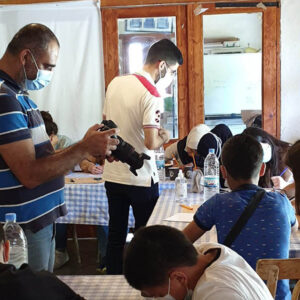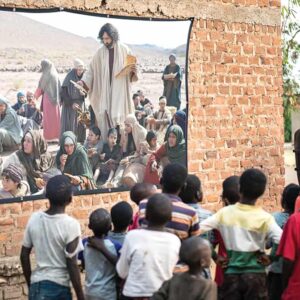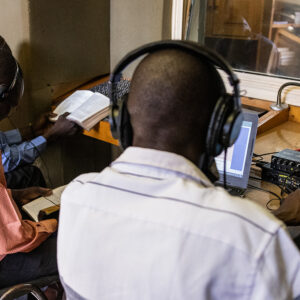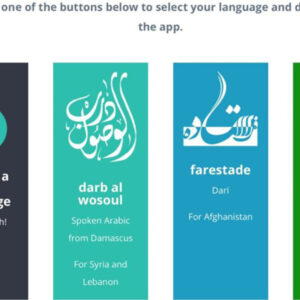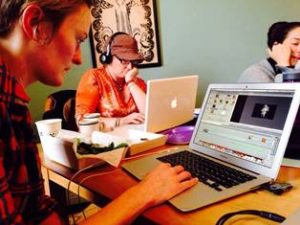
Introduction to Digital Storytelling Webinar. (https://www.storycenter.org/)
HOUSTON, TX (ANS June 8, 2017) — Take a moment to reflect on the last lecture or sermon that captivated your imagination, resonated with you in a meaningful way, and ultimately transformed your thinking.
What elements of this particular talk especially impacted you? Was it the compelling research the presenter reported? The persuasive style in which the content was delivered?
The skillful voice inflection or creative visual aids showcased by presenter? If you were asked to pinpoint the aspects of this speech that still spring to mind today, what would they have in common?
Chances are, these memorable elements in some way relate to — or even revolve around — a story.
Storytelling, by its very nature, captivates us as human beings. We are social creatures, with a natural longing to relate to others. As a person shares a story, our minds instinctively isolate points of connection between their experience and ours. When we find ourselves relating to another’s experience, we innately become more engaged in the story and ultimately more invested in the message being delivered.
Storytelling represents a foundational and significant component of the orality domain. In fact, approximately 80% of the world’s population, or more than 5.7 billion people, are oral learners — either by necessity or preference (International Orality Network, 2017).
Storytelling and orality methods may seem like an antiquated tool in today’s fast-paced, mile-a-minute society, but perhaps this is exactly what makes it so transformative. Life unfolds through the narratives we communicate to one another.
Stories penetrate the boundaries of our hearts – a place where quantitative analysis comes to a screeching halt. Although statistics might persuade, data alone typically fails to inspire action. Storytellers, on the other hand, envelop a central message in a story that sparks the imagination and leaves a lasting imprint on the soul.
Everyone has a story, and whether intentionally or unintentionally, people share bits and pieces of this story through words, actions, and reactions.
Followers of Christ have been challenged with the singular privilege and joy of sharing His story through messages we deliver in daily life — whether at home, in the workplace, or in various other spheres of influence.
For many, it seems more natural to focus on sharing Christ’s message among family and friends than at the office, particularly within secular workplaces.
Yet, quite a few of us spend the majority of our waking hours in our places of employment. What better opportunity to share this most vital message than with those who spend these hours alongside us?
We, Katie and Dawn, spend many of our hours as colleagues in a teacher education program at a university in the heart of the most international city in the United States. In this role, we share the privilege of encountering students from all walks of life and from all corners of the globe.
Through the process of educating preservice and in-service teachers, we face the dual responsibility of not only teaching content knowledge but also modeling effective instructional practices.
Often, we remind our students that through the triumphs and challenges of serving in today’s educational landscape, the art of teaching exemplifies a calling.
Although many of our students do not share our faith in Christ, we connect with them through sharing stories of our teaching experiences – not only at the university, but through our prior experiences as teachers in K-12 educational settings.
Oral storytelling captivates our students’ hearts and minds, and we encourage them to utilize storytelling as a means of captivating their learners as well.
As we teach, we impart life lessons through sharing stories of our own experiences in classroom settings.
Sometimes, these stories simply relate to memories of teaching experiences that succeeded (or flopped!), fruitful collaboration with colleagues, impactful exchanges with administrators, and the like.
Often, however, we find ourselves sharing stories of how our relationship with Christ has impacted our lives as teaching professionals, particularly in relation to our mindsets, motivations, and interactions with students and colleagues.
Why Digital Storytelling or Orality-Based Practices?
Digital storytelling, which is a vital stream within the overall orality movement, enables educators to provide their students a “leg up” by integrating digital innovation into classroom curriculum (Frazel, 2010). From infancy, learners absorb stories articulated and read by those around them, thereby establishing a foundation for realizing stories’ ability to captivate, motivate, and convey knowledge. Today’s students arrive at school not only eager to share stories, but also enthusiastic to construct them through means of technology.
Digital storytelling provides an innovative element to the timeless art of oral storytelling, adding fresh, interactive features to grasp the attention of a digital generation. Today, an endless stream of media — including images, music, podcasts, and videos — comprise a broad range of raw materials for meaningful storytelling. Not surprisingly, students in today’s world eagerly anticipate opportunities to utilize such tools for inventing and interacting (Prensky, 2010). Digital stories hold tremendous potential to enrich students’ lives. These stories provide them an avenue through which to share messages emanating from the core of their beings – not only with classmates but ultimately with others around the world.
In our graduate education program, one of our online classes emphasizes multimedia instructional strategies.
The first major project in this course requires that students collaborate online to develop a digital story convincing others of the importance and impact of the profession of teaching. Each semester, our students report this assignment to be among the most transformative. No wonder, when it provides them the opportunity to jointly construct meaning from ideas and concepts, transferring their learning to new experiences shared with others. Through storytelling, they tackle authentic issues, share their findings with authentic audiences, and ultimately engage in authentic assessment of their learning.
However, the impact of orality concepts and digital storytelling are not limited to adult learners. In fact, it is transformational for even the youngest of children.
While teaching elementary school, Katie’s second grade students once created autobiographical “documentaries,” showcasing the most meaningful moments in their lives through personal photographs and scripts they penned themselves. This offered a unique avenue by which to introduce themselves to classmates at the start of the school year. For example, young Lindy’s documentary showcased distinctive family photographs, from the day of her birth through her through her family camping trip to the Grand Canyon and her most memorable holidays spent baking in her grandmother’s kitchen. After viewing her digital masterpiece, she smiled with uninhibited delight and excitedly declared, “I can’t believe I’m starring in a movie!” Numerous students and their parents remarked that this was among the most impactful and unforgettable projects we created that year.
For followers of Christ — whether teachers or students — digital storytelling provides a vehicle through which to mesh visual and auditory elements to help convey the greatest story ever told. Such storytellers utilize images, narration, music, and video working in concert to share the good news of Jesus Christ with a watching world.

Long known as Christian music’s premier live band, the Atlanta-based Third Day has performed for audiences reaching into the millions all around the world.
In another of our graduate courses, students have the opportunity to create a music video. This project involves a song of their choosing, which coalesced with a series of images is intended to convey a distinct message. For our Christian students, this assignment provides an ideal platform through which to share the transformative message of the gospel with others, and some have taken a step of faith in doing so. When Katie was a graduate student in this course, she created a video based upon Third Day’s unforgettable Love Song (Carr, Avery, Powell, Anderson, & Lee, 1996). The song’s lyrics begin with this poignant illustration:
I’ve heard it said that a man would climb a mountain,
Just to be with the one he loves.
How many times has he broken that promise?
It has never been done.
I’ve never climbed the highest mountain,
But I walked the hill of Calvary.
And, the story continues from the perspective of Christ:
Just to be with you, I’d do anything
There’s no price I would not pay
Just to be with you, I’d give anything
I would give my life away.
The story concludes with these truths:
I know that you don’t understand
The fullness of My love,
How I died upon the cross for your sins.
And I know that you don’t realize
How much that I gave you.
But I promise, I would do it all again.
Just to be with you, I’ve done everything.
There’s no price I did not pay.
Just to be with you, I gave everything.
Yes, I gave my life away.
As the story unfolds through song, images depicting the lyrics simultaneously flash upon the screen — from majestic mountain peaks to heartrending paintings of Christ’s ascent to Calvary.
The intermingling of music, lyrics, and images paints a vivid picture of Christ’s sacrificial and redemptive love, captivating the attention and rendering a lasting impact upon the viewer’s heart and mind.
In educational settings, a digital storytelling expedition commences with a roadmap of curricular goals to guide the way for tackling the concepts to be learned. After isolating desired learning objectives, teachers should offer reasonable guidelines and criteria for assessing the project. Teacher-created examples effectively support learners in visualizing a finished product. As students begin to organize their resources, they might gather storyboards, scripts, images, audio files, and videos in digital file folders. After students incorporate the resources they gather in a preliminary digital story, peer review might play a role in the concluding stages of the project.
Although the digital storytelling audience may be limited to the teacher and classmates, they will more likely seek to reach a wider audience through uploading their stories to the Internet.
For those considering the prospect of incorporating digital storytelling into learning, many free, teacher, and student-friendly resources exist on the Internet, no further than a click away. One groundbreaking website, the Educational Uses of Digital Storytelling (http://digitalstorytelling.coe.uh.edu), is devoted to offering teachers essential tools for integrating digital storytelling into learning experiences. This expansive site exhibits exemplars, tools, and guidelines for creating digital stories.
The Center for Digital Storytelling (http://storycenter.org/), a worldwide non-profit organization, is another beneficial resource. The Center’s all-encompassing website provides case studies and examples of digital stories spanning early childhood through university settings, even comprising specialized workshops for teachers.
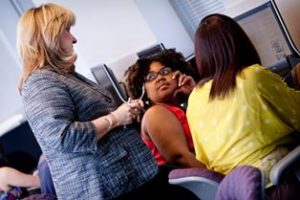
Dr. Dawn Wilson teaching the classroom. (Photo courtesy of Houston Baptist University / Michael Tims).

Dr. Katie Alaniz teaching. (Photo courtesy of Houston Baptist University / Michael Tims).
Seasoned educators realize that the creative genius of students cannot be underestimated, especially when provided the opportunity to integrate their penchant for digital innovation. In today’s information-saturated world, storytelling is being revitalized as a unique tool for enabling leaners to sift through an ambush of data and craft meaning of the world around them. The digital storytelling process channels imperative concepts into distinctive opportunities for lasting learning.
By journeying together with students as they design and publish their stories, teachers breathe new life into learning endeavors.
While the world around us moves at breakneck speed, we face the imperative of making every moment here on earth count for eternity. As in any setting, followers of Christ within the educational arena must leverage each opportunity to share His good news using relevant formats. Digital storytelling provides an avenue through which to accomplish this unparalleled mission. When students witness and create stories of Christ brought to life through digital storytelling, hearts and minds are captivated, and lives are ultimately transformed for eternity.
References:
Carr, D., Avery, B. B. C., Powell, J. M., Anderson, S. T., & Lee, M. D. (1996). Love Song [Recorded by Third Day]. On Third Day [CD]. Nashville, TN: Reunion Records.
Frazel, M. (2010). Digital storytelling guide for educators. Eugene, OR: International Society for Technology in Education.
International Orality Network (2017). Who are oral learners? Retrieved from https://orality.net/about/who-are-oral-learners/
Prensky, M. (2010). Teaching digital natives: Partnering for real learning. Thousand Oaks, CA: Corwin.
About the writers:
 Dr. Katie Alaniz teaches education courses at Houston Baptist University. She has collaboratively authored two books on digital learning, published several academic articles, and presented at a variety of educational conferences.
Dr. Katie Alaniz teaches education courses at Houston Baptist University. She has collaboratively authored two books on digital learning, published several academic articles, and presented at a variety of educational conferences.
 Dr. Dawn Wilson’s teaching focus is on graduate and pre-service teachers’ methods and tools for incorporating technology into the K12 curriculum. She has published several academic articles and co-authored two books.
Dr. Dawn Wilson’s teaching focus is on graduate and pre-service teachers’ methods and tools for incorporating technology into the K12 curriculum. She has published several academic articles and co-authored two books.
« Intersection: Stories Impacting women in Ethiopia The only question left… »




